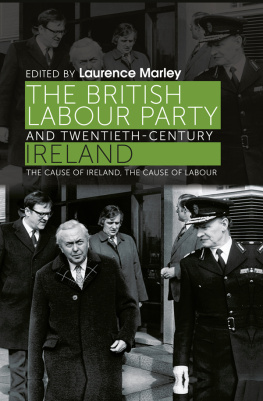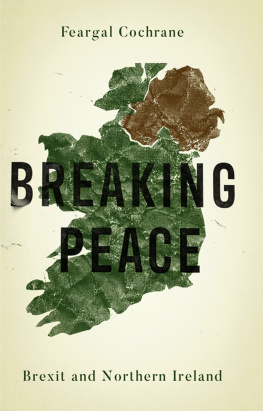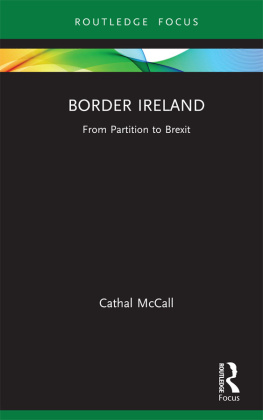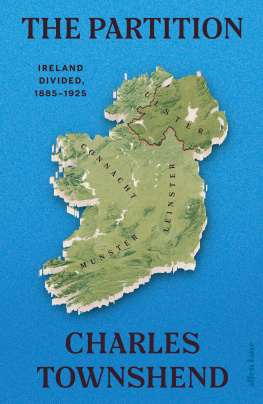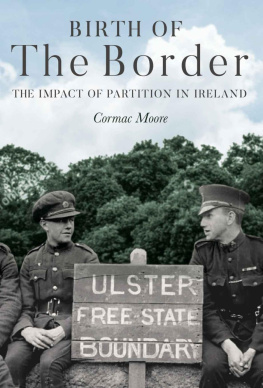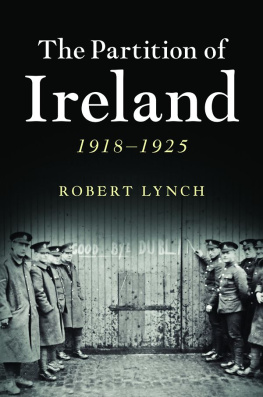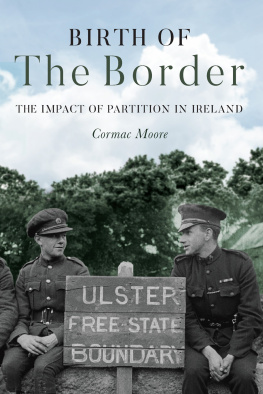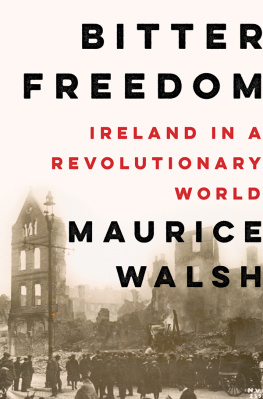Contents
Pagebreaks of the print version
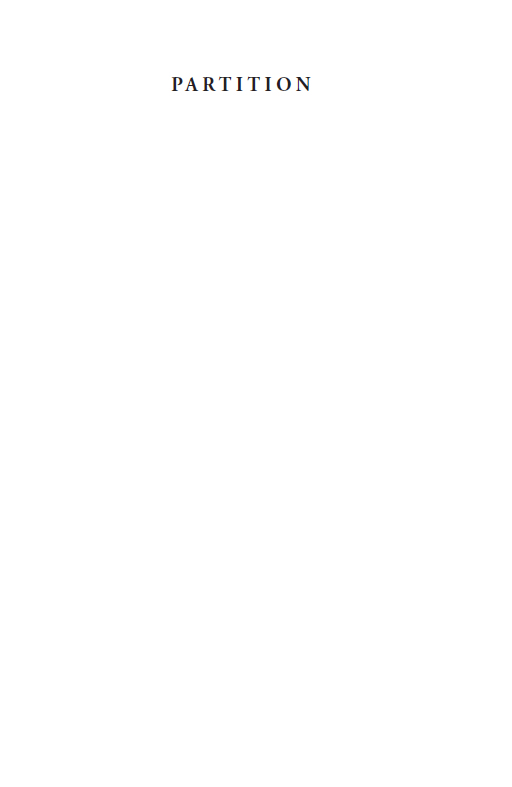
ABOUT THE AUTHOR
Dr Ivan Gibbons is former Programme Director of Irish Studies at St Marys University, London and a member of the Board of Directors at Hammersmith Irish Cultural Centre, London. He is a lecturer and writer on twentieth-century British and Irish History and author of Drawing the Line: The Irish Border in British Politics and The British Labour Party and the Establishment of the Irish Free State 19181924.

First published in 2020 by
HAUS PUBLISHING LTD
4 Cinnamon Row
London SW11 3TW
Copyright Ivan Gibbons, 2020
For quotes reproduced from the speeches, works and writings of
Winston S. Churchill:
Reproduced with permission of Curtis Brown, London on behalf of
The Estate of Winston S. Churchill.
The Estate of Winston S. Churchill
Sections of this book first appeared under the title Drawing the Line in
Haus Publishings pamphlet series, the Haus Curiosities, in 2018.
Cartography produced by ML Design
Maps contain ordnance survey data
Crown Copyright and Database Right 2011
A CIP catalogue record for this book is available from the British Library
Ivan Gibbons has asserted his right under the Copyright, Designs and Patents
Act 1988 to be identified as author of this work
ISBN: 978-1-913368-01-2
eISBN 978-1-913368-02-9
Typeset in Garamond by MacGuru Ltd
Printed in the United Kingdom by Clays Ltd, Elcograf S.p.A.
www.hauspublishing.com
For my sister, Virginia
Thanks to Hilda for all her advice and support
Introduction
T he fact that partition was the single most important event in the history of the island of Ireland during the course of the twentieth century has, surprisingly, been downplayed by many Irish historians Professor Ronan Fanning even went so far as to dismiss it as a story well known and soon told.
As a historian teaching Irish history to university and adult education students in London, I always noticed a certain diffidence and reluctance to discuss the implications and consequences of this event in Irish history, the centenary of which we are commemorating. I wondered if this was because the Troubles in Northern Ireland of the late twentieth century were caused by, or, at least, heavily influenced by, this controversial event. I also noticed that students from Northern Ireland were far more ready to talk about the border than their fellow students from the south. Was there an element of guilt about how the south had allegedly abandoned the north all those years ago? It was clear that the drawing of the border was still a very raw event in the minds of so many Irish people. The occasion of its centenary in 2021 gives us an opportunity to learn about the story behind this momentous event, one that has so influenced Anglo-Irish relations for many decades.
Over almost forty years of teaching, I have always admired particularly those adult education students who, on a purely voluntary basis, came to learn more about Ireland and its relationship with Britain at a time when it wasnt always popular in this country to identify as Irish or want to know more about Ireland. I often wondered what the students motivations were. In the case of those with no obvious link to Ireland it was more straightforward than it was for those with some Irish connection a genuine attempt to understand the historical background to the story behind the news headlines. Each time something new was learned the inevitable comment was that they just hadnt been taught any of this at school!
The response of Irish-born students and those with Irish connections was far more nuanced. Most were there because they wanted to know more about their country, learning together with similar-minded Irish people at a time when it was problematic, to say the least, for many people to be Irish and living in London, despite the fact that, in most cases, they had made their whole lives there.
However, as central an event as partition was in Ireland, it is also immensely important in a wider context as Irelands contribution to the great post-First World War upheavals in Europe (the partition proposal in the Anglo-Irish Treaty in 1921 appeared at the same time as the debate over how to divide Silesia between Germany and Poland). Ireland was not the only European country to be carved up in the tumultuous period after 1918. The fashionable political concept at the Treaty of Versailles, the peace agreement that concluded the First World War, was that of self-determination. But attempting to untangle the varied political and national mix in the north of Ireland proved as problematic as attempting to do the same in central and eastern Europe. Silesia and East Prussia were as difficult to resolve as Ulster, and efforts to do so contained the seeds for future conflict.
Ireland was also the first of the partition proposals to be implemented in the subsequent decolonisation of the British Empire where, in the cases of India and Palestine, Irelands example was seen as a suitable constitutional example to be followed. The British Empire had traditionally operated a successful policy when confronted with potential or actual conflict between continued membership of the Empire and the desire for self-determination of the peoples therein. This involved applying a full measure of self-government inside a federal structure, which seemed to have worked well in Canada and South Africa. But in cases of conflicting allegiances and national identities where competing claims for self-determination collided with each other such as in Ireland, India and Palestine the system began to break down. Partition was not the first choice of the British government in any of these cases. There is no evidence that Britain had a prepared divide-and-rule partitionist agenda for which Ireland was the template and which it found intrinsically attractive and was prepared to implement automatically. Indeed, there is evidence in all these cases that Britain would have preferred to have implemented alternative solutions but was defeated by the sheer acceleration of events and fear of the possible consequences of an unpredictable outcome to these developments.
The partition of Ireland was also part of the great debate as to the future constitutional composition of the United Kingdom at the beginning of the twentieth century. Time has erased, or at least diluted, the memories of the tumultuous opening decades of the last century in Ireland. The south has metamorphosed into todays secular sovereign European state, while in the north the politics of parity of esteem has changed the former unionist province into, theoretically at least, a model of democratic power-sharing. But the border remains the border a century on, and the tensions, emotions and sensitivities that led to its creation are as powerful today as they were a hundred years ago.
Partition, or the threat of partition, had been part of the political background in Ireland ever since Irish nationalism began to assert itself in the late nineteenth century. The threat of loosening, or even removing, constitutional links with Britain was always going to attract an adverse reaction from Irish unionists, particularly those concentrated in numbers in the north-east of the country. Partition only became an overt and controversial political issue following the introduction of the Third Home Rule Bill in 1912; it had not featured at the time of the First Home Rule Bill in 1886 or the Second Home Rule Bill in 1893 mainly because these had been defeated with relative ease at Westminster, the first in the Commons and the second in the Lords. However, it was already apparent by the 1880s that nationalist Irelands growing desire for autonomy posed an increasing threat to the constitutional framework of the existing United Kingdom. Opponents of William Gladstones commitment to Irish self-government argued that only a federal United Kingdom could prevent the potential constitutional dislocation that might be triggered by the introduction of a separate political structure created solely to satisfy Irish nationalist demands. Essentially, granting Home Rule to Ireland would create what became known over a century later during the debate on Scottish and Welsh devolution as the West Lothian question: bestowing upon a region of the United Kingdom, in this case Ireland, a parliament of its own while retaining that regions parliamentary presence at Westminster would give Ireland the right to vote on the internal affairs of England, Scotland and Wales without those countries being able to vote on internal Irish affairs. Gladstones solution was to curtail Irish representation at Westminster, but to his opponents on the Home Rule issue, such as Joseph Chamberlain, this would mean that consequently Ireland would no longer have equal status inside the United Kingdom. To Chamberlain the ideal solution was to apply the federal model of Canada across the United Kingdom as an alternative to Home Rule in just one part; otherwise Gladstone was simply giving priority to Irish national grievances over social grievances in England and Scotland. Confronted with Irish Home Rule in the 1880s, Chamberlain preferred a proposed British federation with subordinate parliaments in Edinburgh, Cardiff, Dublin and, because of unionist opposition to rule from Dublin, Belfast as well. This would involve strictly demarcated roles with Westminster responsible for foreign affairs, defence, post office and customs, with the regional assemblies responsible for the rest.



